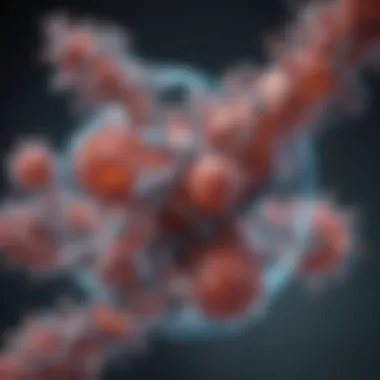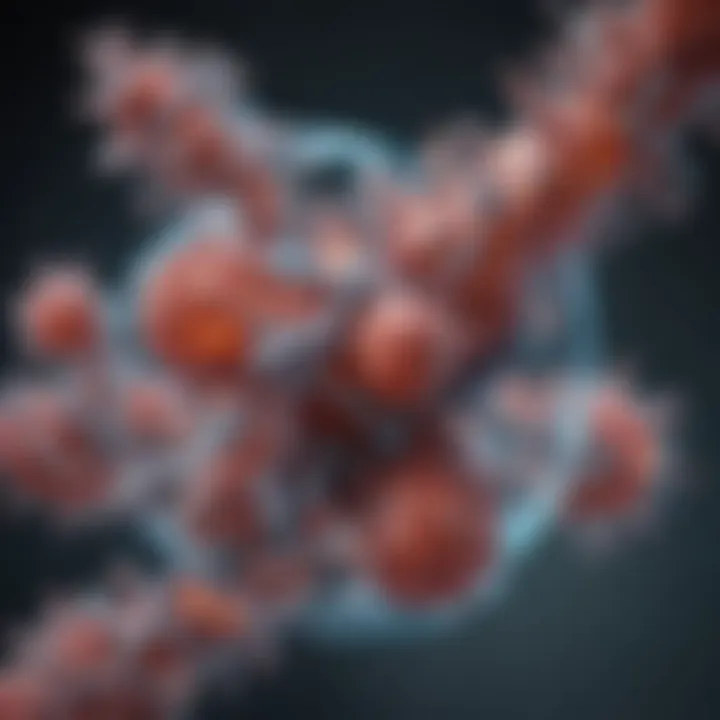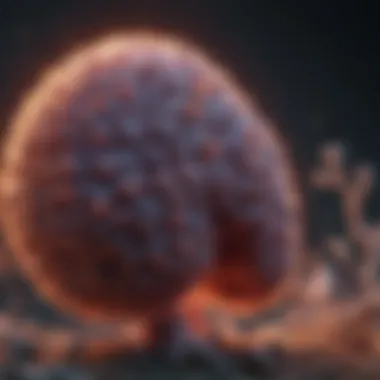RET Rearrangement in Lung Cancer: Mechanisms & Implications


Intro
RET rearrangements in lung cancer have emerged as a crucial focus in oncological research. Advances in molecular biology reveal that these genetic alterations play a significant role in the carcinogenesis process. Understanding the mechanisms that underlie RET fusion proteins can pave the way for personalized treatment strategies. This article delves deeply into the nuances of RET rearrangements, exploring their fundamental importance in lung cancer therapies.
Recent Advances
Latest Discoveries
Recent studies have underscored the prevalence of RET rearrangements in lung adenocarcinoma, particularly among younger patients and non-smokers. For instance, RET fusions such as KIF5B-RET have been linked with defining characteristics of lung tumors.
Researchers utilized genomic sequencing to identify RET fusions, demonstrating that these alterations can drive tumorigenesis directly. The identification of these fusions is significant as they mark potential targets for intervention with specific inhibitors, leading to favorable patient outcomes.
Technological Innovations
Innovative diagnostic tools have transformed how RET rearrangements are detected. Advanced techniques such as next-generation sequencing (NGS) provide comprehensive profiling, detecting not only RET fusions but also co-existing alterations typical in lung cancer. Additionally, liquid biopsies have emerged as a minimally invasive method to identify genetic alterations in circulating tumor DNA, allowing for real-time monitoring of treatment responses and disease progression.
"The shift towards molecular profiling in lung cancer will undoubtedly change how we approach treatment, especially with respect to RET rearrangements."
Methodology
Research Design
The study of RET rearrangements often involves a multi-faceted research design integrating laboratory assays and clinical data. Researchers typically adopt prospective cohort studies to observe the impact of targeted therapies on patients with RET fusions. This approach allows for a detailed analysis of treatment efficacy and patient response.
Data Collection Techniques
Data collection strategies vary but should prioritize accuracy and completeness. Techniques include:
- Tissue biopsy analysis: extracting tumor samples to analyze genetic material for RET fusions.
- Patient demographics: compiling data on age, gender, smoking history, and other relevant factors to identify patterns in RET rearrangement occurrences.
- Longitudinal studies: following patients over time to observe treatment outcomes and disease progression.
By synthesizing this information, researchers aim to create a comprehensive understanding of RET rearrangements in lung cancer and enhance therapeutic approaches.
Prelims to RET Rearrangements
RET rearrangements have emerged as a crucial topic within lung cancer research. This area of study focuses on the genetic alterations associated with the RET gene, which plays a significant role in oncogenic processes. By understanding RET rearrangements, professionals can better grasp their implications for diagnostics and therapy. This section aims to clarify the concept of RET rearrangements and their overarching significance in lung cancer, providing foundational knowledge essential for the subsequent discussions in this article.
Definition of RET Rearrangement
RET rearrangement refers to structural changes that occur in the RET proto-oncogene. These changes typically involve the fusion of the RET gene with other genes, resulting in hybrid genes that can drive oncogenic signaling. The fusion often leads to the production of abnormal proteins that can activate pathways related to cell growth and proliferation. This genetic modification is generally caused by chromosomal translocations, insertions, or deletions, which culminate in unregulated signaling and tumor development.
Significance in Lung Cancer
The significance of RET rearrangements in lung cancer cannot be overstated. These mutations offer important insights into the tumor biology of affected patients. Here are key points regarding their relevance:
- Biomarker for Targeted Therapy: RET rearrangements serve as specific biomarkers that can guide therapy choices. Targeted treatments such as selpercatinib and pralsetinib have demonstrated efficacy against RET-positive tumors. This targeted approach enhances treatment precision compared to traditional therapies.
- Impact on Patient Demographics: Studies indicate that RET rearrangements have distinct demographic profiles, often appearing in younger patients who are non-smokers. Understanding these demographics aids in identifying patients who may benefit from genetic testing and targeted interventions.
- Research Implications: RET rearrangements stimulate ongoing research into their mechanisms and interactions with other oncogenes. This research is crucial for developing innovative treatments and improving patient outcomes.
"RET rearrangements highlight the intersection of genetics and treatment strategies in lung cancer, marking a significant step towards personalized medicine."
In summary, RET rearrangements are a pivotal element in lung cancer research, shaping our understanding of tumorigenesis and paving the way for more effective and individualized treatment strategies. This article will delve deeper into these aspects, providing a comprehensive exploration of the topic.
Molecular Mechanisms of RET
The molecular mechanisms associated with RET rearrangements are pivotal to understanding lung cancer progression. RET, which stands for rearranged during transfection, is a gene that codes for a receptor tyrosine kinase involved in several biological processes, including cell growth and differentiation. Its dysfunction, particularly through rearrangements, contributes to oncogenesis in various cancers, especially lung cancer. The exploration of these mechanisms sheds light on potential therapeutic targets and helps in developing more effective treatment strategies.
Genetic Basis of RET Rearrangements


RET rearrangements occur through various genetic alterations, most notably chromosomal translocations and inversions. These genetic changes can lead to the fusion of the RET gene with other genes, which can play a significant role in the development of cancer.
Key points include:
- Common Fusion Partners: Some common partners for RET include KIF5B and CCDC6. The involvement of these partners alters the normal function of RET and promotes tumor growth.
- Incidence and Detection: Usually, RET rearrangements can be found in approximately 2-3% of lung adenocarcinomas. They can be detected through various techniques like fluorescence in situ hybridization (FISH) and next-generation sequencing (NGS).
Formation of RET Fusion Genes
The fusion of RET with other genes leads to pathologically active fusion proteins. These proteins typically retain the oncogenic potential associated with the original RET sequence while acquiring new properties from the partner gene.
- Mechanism of Fusion Formation: The process of forming RET fusion genes is often consequent to errors during DNA repair or replication, creating a new gene product that may drive uncontrolled cellular proliferation.
- Stability and Functionality: Some resulting fusion proteins exhibit stability and promote activity of the downstream signaling pathways that are critical for tumor development.
Impact on Cellular Signaling Pathways
RET rearrangements have a notable impact on the cellular signaling pathways that govern cell survival and proliferation. When RET is involved in the oncogenic process, it activates multiple downstream effectors that lead to tumorigenesis.
- Key Pathways Involved: RET fusions primarily impact the RAS-MAPK and PI3K-AKT pathways, both of which are essential in regulating cell division, apoptosis, and metabolism.
- Clinical Relevance: Understanding these pathways allows researchers to devise targeted therapies that can inhibit abnormal signaling, which is especially relevant as new therapies continue to emerge.
"Targeted therapies that inhibit RET fusion proteins can offer hope in managing lung cancer more effectively."
The elucidation of these molecular mechanisms illuminates potential avenues for personalized medicine in lung cancer treatment, establishing a foundation for further research and clinical applications.
Clinical Implications of RET Rearrangements
Understanding the clinical implications of RET rearrangements is crucial in the context of lung cancer treatment and prognosis. RET rearrangements serve as significant biomarkers that can influence therapeutic decisions. Their presence can help oncologists to tailor treatment strategies that can lead to improved patient outcomes. The integration of this information creates a more personalized approach, which is becoming increasingly paramount in modern oncology. Moreover, recognizing the demographics and clinical profiles associated with these rearrangements can refine our understanding of lung cancer pathology.
Demographics of Patients with RET Rearrangements
Research indicates that RET rearrangements are not uniformly distributed across the lung cancer population. Certain demographic patterns emerge regarding gender and age. For example, studies suggest that patients with RET rearrangements are often younger than those with other forms of lung cancer. Additionally, there is a noticeable trend toward a predilection for non-smokers, which contrasts with typical lung cancer demographics where smoking is a significant risk factor.
- Age Range: Most affected individuals are usually between 40 to 60 years.
- Gender Disparity: A slight male predominance exists, although the difference is not stark.
Patients with RET rearrangements can often present with adenocarcinoma of the lung, which has shown marked correlation with the presence of these genetic alterations.
Prognostic Factors Associated with RET Rearrangements
The presence of RET rearrangements in lung cancer carries certain prognostic implications that can influence patient management strategies. For instance, they are generally associated with a more favorable response to targeted therapies, particularly those involving RET inhibitors. This aspect emphasizes the potential of personalized medicine, offering hope for improved survival rates.
Several factors are significant in determining the prognosis for patients with RET rearrangements:
- Tumor Stage: Early-stage tumors tend to have better outcomes compared to advanced stages.
- Response to Treatment: Effective targeting of RET leads to better maintenance of disease control.
- Co-occurring Mutations: The presence of additional genetic mutations can sometimes complicate prognostic outcomes.
"Understanding the unique characteristics of RET rearrangements helps in optimizing therapies and improves patient quality of life."
By focusing on RET rearrangements, clinicians can employ more targeted and effective strategies, leading to enhanced prognostic factors. The knowledge around these specific alterations impacts various patient outcomes, underlining the importance of comprehensive molecular profiling in lung cancer.
Diagnostic Approaches
Diagnostic strategies for RET rearrangements in lung cancer are crucial. They play a significant role in identifying the presence of these genetic alterations. Accurate detection impacts treatment decisions and patient outcomes. As the field of lung cancer research evolves, understanding the methodologies for diagnosing RET rearrangements becomes more essential. This knowledge helps clinicians tailor therapies and improve patient survival rates.
Techniques for Detecting RET Rearrangements
Several techniques are employed to detect RET rearrangements in lung cancer. Each method has its benefits and limitations. Here are some common approaches:
- Fluorescence In Situ Hybridization (FISH): FISH is a widely used technique. It involves using fluorescent probes to bind to specific regions of DNA. This method allows for visualization of RET gene rearrangements at the cellular level.
- Reverse Transcription Polymerase Chain Reaction (RT-PCR): RT-PCR is effective in identifying the presence of RET fusion transcripts. This technique amplifies RNA sequences, enabling the detection of specific gene fusions associated with RET rearrangement.
- Next-Generation Sequencing (NGS): NGS allows for comprehensive genetic profiling. It can simultaneously assess multiple genes, providing information on RET rearrangement and other mutations. This method is increasingly popular due to its high sensitivity.
- Immunohistochemistry (IHC): IHC detects protein expression levels related to RET rearrangement. While not a direct measure of genetic alteration, it provides complementary information that may guide treatment choices.
Each of these techniques has distinct advantages. For instance, while NGS offers extensive profiling, FISH provides immediate visualization. Ultimately, the choice of methodology depends on the clinical context and available resources.


Role of Biomarkers in Diagnosis
Biomarkers play an integral role in the diagnosis of RET rearrangements. They provide essential insights into the molecular characteristics of lung tumours. Here’s how biomarkers contribute:
- Specificity: Biomarkers help in specifically identifying RET rearrangements. This is vital for distinguishing between types of lung cancer, particularly non-small cell lung cancer (NSCLC).
- Predictive Value: Certain biomarkers can predict how a patient may respond to targeted therapies. Understanding the presence of RET rearrangement can guide oncologists in selecting appropriate treatments, such as targeted therapies.
- Monitoring Treatment Response: Biomarkers can also be utilized to monitor a patient's response to treatment. Changes in biomarker levels may indicate whether a patient is benefitting from a particular therapeutic approach.
Understanding the role of biomarkers in the diagnosis of RET rearrangements enhances the precision of lung cancer treatment.
In summary, the diagnostic approaches for RET rearrangements in lung cancer offer significant insights. Techniques such as FISH and NGS provide the means to identify these genetic alterations effectively. Meanwhile, biomarkers facilitate a more personalized treatment strategy, ultimately improving patient outcomes.
Treatment Strategies for RET Rearrangement in Lung Cancer
RET rearrangements significantly influence treatment choices for lung cancer patients. Understanding these strategies is vital, as it allows for optimal patient management and improves outcomes. Treatment approaches focus on targeting the genetic alterations identified in RET rearrangements. This specificity not only provides a deeper understanding of the cancer's biology but also enhances the potential for personalized therapy, which is becoming increasingly important in oncology.
Targeted Therapies for RET Rearrangements
Targeted therapies have emerged as a promising option in treating RET-rearranged lung cancer, particularly non-small cell lung cancer (NSCLC). These therapies are designed to inhibit the signaling pathways driven by RET fusion proteins. The use of targeted agents like vandetanib, cabozantinib, and larotrectinib has shown notable efficacy in clinical trials.
- Vandetanib is primarily a VEGFR inhibitor, which has been used in other cancer types but shows some activity against RET.
- Cabozantinib is notable for its multi-targeting capability; it inhibits several tyrosine kinases, including RET, making it versatile in application.
- Larotrectinib has been pivotal in offering robust responses specifically for tumors harboring RET fusions.
The precision of these therapies provides benefits such as:
- Reduced side effects compared to traditional chemotherapy due to specificity.
- Opportunities for patients with treatment-resistant cancer.
However, careful monitoring is necessary as resistance can develop over time, emphasizing the need for ongoing research and adaptation.
Chemotherapy and Immunotherapy Options
While targeted therapies represent a significant advancement, traditional treatments such as chemotherapy and immunotherapy still play important roles in managing RET rearrangement lung cancer. Chemotherapy is often a backbone treatment, especially in patients with advanced disease when immediate action is warranted.
- Platinum-based regimens such as carboplatin or cisplatin are commonly used but may yield variable results depending on the tumor’s profile.
- Immunotherapy, particularly agents like nivolumab or pembrolizumab, is also worth mentioning. These monoclonal antibodies can enhance the body's immune response against tumors, though their effectiveness can be influenced by the unique molecular landscape present in RET-rearranged cancers.
Combination therapies may yield synergistic effects, enhancing overall therapeutic outcomes. As research progresses, understanding the best integration of these modalities is crucial. Emerging protocols aim to refine treatment plans to ensure the most appropriate and effective strategies for those affected by RET rearrangements.
"The evolution of treatment strategies for RET rearrangements exemplifies the transition from generalized cancer therapies to tailored approaches, highlighting the promise of personalized medicine in oncology."
Current Research and Advances
Research on RET rearrangements in lung cancer plays a vital role in informing both clinical practice and the development of innovative therapies. Such research efforts are focused on understanding the complexities of RET fusion proteins and how they contribute to tumorigenesis. This section outlines recent progress in identifying emerging drug candidates and highlights key clinical trials that are examining their efficacy in treating lung cancer.
Emerging Drug Candidates
As the field of personalized medicine evolves, new drug candidates targeting RET rearrangements are gaining attention. Recent studies have yielded promising agents that selectively inhibit the activity of RET fusion proteins. These include:
- Selpercatinib (LOXO-292): This is a highly selective RET inhibitor. It shows significant activity in patients with RET fusion-positive non-small cell lung cancer (NSCLC).
- Pralsetinib (BLU-667): Another potent RET inhibitor that has shown success in early clinical trials. Patients with advanced RET-altered cancers exhibited positive outcomes after treatment.
- RXDX-105: Currently undergoing evaluation, this drug candidate also aims at RET inhibition and has garnered interest due to its potential effectiveness.
These agents offer hope for a more targeted approach in treating lung cancers driven by RET rearrangements. Their development reflects a significant advancement in our understanding of the genetic underpinnings of lung cancer and highlights a shift towards tailoring therapies based on specific genetic alterations.
Clinical Trials and Their Findings
Clinical trials are essential for assessing the safety and efficacy of new treatments for RET rearrangements. Recent studies have provided critical insights:
- Trial Assessing Selpercatinib: This trial revealed an overall response rate of over 60% in RET-positive lung cancer patients, indicating its effectiveness in halting disease progression.
- Pralsetinib’s Phase 1/2 Trial: Demonstrated promising results with durable responses observed in participants. The trial also suggested a manageable safety profile, which is crucial for long-term treatment consideration.
- Combination Therapies: Some trials explore combining RET inhibitors with immunotherapy and chemotherapy to maximize patient outcomes. Early findings suggest that these combinations can enhance efficacy and overcome resistance mechanisms.
Clinical trials are crucial pathways for turning laboratory discoveries into effective treatments. Their findings often lay the groundwork for new standards in care.


The ongoing research in this field is making strides toward better management of lung cancer. It is essential to remain updated on these developments, as they continuously reshape treatment landscapes for those affected by RET rearrangements.
Future Perspectives
Understanding the future perspectives of RET rearrangement in lung cancer is crucial for various reasons. The landscape of cancer treatment is changing, with increasing emphasis on personalized medicine. Since RET alterations can significantly impact the progression and treatment response of lung cancer, ongoing research is vital. This future outlook highlights pathways for improvement in patient care and overall outcomes.
Potential for Personalized Medicine
The potential for personalized medicine in the context of RET rearrangements is immense. Identification of RET fusions can tailor treatments to individual needs, which may improve efficacy and reduce side effects. Advances in molecular profiling allow clinicians to know which therapies will work better for specific RET-related profiles.
- Targeted therapies such as selpercatinib and pralsetinib have shown promising results in clinical trials. These treatments specifically target RET fusions, leading to better responses in patients with lung cancer.
- Ongoing genomic research can further refine how various RET alterations respond to different medications. This could guide oncologists in choosing the most effective strategies.
An ideal implementation would allow for a seamless integration of molecular diagnostics into clinical settings, facilitating real-time adjustments in treatment plans.
Importance of Multidisciplinary Approaches
A multidisciplinary approach plays a critical role in the management of lung cancer with RET rearrangements. Collaboration among oncologists, pathologists, geneticists, and other specialists is essential to optimize patient outcomes. Here are key aspects that underline the importance of this collaboration:
- Comprehensive patient evaluation: Different specialists can assess various aspects of a patient’s condition, leading to more precise diagnoses and treatment plans.
- Holistic treatment planning: Input from various experts can ensure that both targeted therapies and supportive care measures are considered, improving quality of life.
- Enhanced research opportunities: Multidisciplinary teams can foster an environment for innovative studies. This could lead to the discovery of novel therapeutic options and a better understanding of resistance mechanisms.
The integration of multidisciplinary approaches in lung cancer management not only standardizes care but also elevates the scale of research efforts.
As we move forward, the focus on RET rearrangements in lung cancer will undoubtedly benefit from these concerted efforts, paving the way for better treatment paradigms.
Ethical Considerations
The discussion around RET rearrangements in lung cancer extends beyond molecular mechanisms and clinical implications. It brings forth a range of ethical considerations that demand attention from healthcare professionals, researchers, and patients alike. Notably, ethical aspects play a vital role in the evolving landscape of genetic testing and the use of RET as a biomarker in personalized medicine. It is essential to understand these aspects to inform best practices and ensure patient rights and well-being are safeguarded.
Ethics of Genetic Testing
Genetic testing for RET rearrangements presents several ethical concerns. The primary issue is the potential for discrimination based on genetic information. Patients may fear that their genetic data could be misused by employers or insurance companies, leading to a reluctance to undergo testing. In some cases, the knowledge of having a specific genetic alteration could affect an individual’s mental health or their familial relationships.
Moreover, the test's implications may not be limited to the individual. As genetic information is often hereditary, it can have consequences for family members. Appropriate counseling before genetic testing is critical to address such complexities.
Importantly, there can be variations in the access to genetic testing based on socio-economic status or geographical location, thus raising fairness issues. Patients must be aware of their rights regarding genetic information and the importance of making informed choices.
Informed Consent in RET Testing
Informed consent is another cornerstone of ethical considerations in genetic testing. Patients should fully understand what the testing involves, its purpose, and any possible outcomes before giving their consent. This process includes discussing the risks and benefits associated with RET testing and potential management changes based on results.
Patients have the right to ask questions about their testing procedure. They should be informed about how their genetic data will be used, who will have access to it, and what it could mean for their treatment options. Providing clear and concise information can lead to more meaningful consent.
Informed consent is not merely a formality. It reflects respect for the patient’s autonomy. As the field of lung cancer research continues to evolve, focusing on ethical considerations will enhance research integrity and foster trust among patients and healthcare providers.
"Ethics in genetic testing must prioritize patient welfare and informed decision-making to pave the way for responsible advancements in lung cancer treatment."
By addressing these ethical considerations, the ongoing discourse can create a better framework for handling genetic testing for RET rearrangements, ensuring that ethical principles guide research and clinical practice.
Epilogue
RET rearrangements in lung cancer hold significance not just in the context of molecular mechanisms but also in their implications for targeted treatment approaches. Understanding these arrangements offers insight into how cells develop malignancies, contributing to more personalized medical strategies. This article has explored how RET fusion proteins influence tumorigenesis, underlining the complexity of genetic alterations in lung cancer.
Summary of Key Points
- Definition and Significance: RET rearrangements are critical genetic alterations in lung cancer that warrant thorough exploration. Their implications provide a pathway for targeted therapies that can improve patient outcomes.
- Molecular Mechanisms: This includes the genetic basis of RET rearrangements, formation of fusion genes, and their impact on signaling pathways that drive tumor growth.
- Clinical Insights: Understanding patient demographics and prognostic factors is essential, as it influences treatment options and outcomes.
- Diagnostic Approaches: Techniques such as next-generation sequencing and the role of biomarkers in diagnosis are crucial for identifying RET rearrangements effectively.
- Treatment Strategies: Targeted therapies, in combination with immunotherapy and chemotherapy, illustrate the evolving landscape of treatment options.
- Current and Future Research: Emergent drug candidates and clinical trials are vital for forging new frontiers in lung cancer therapy.
- Ethical Considerations: Issues around genetic testing and informed consent are paramount in the discussion about RET testing.
Future Directions in Research
Research into RET rearrangements in lung cancer is ongoing and evolving. Future studies may focus on:
- Refining Targeted Therapies: Enhancing the specificity and efficacy of existing drugs targeting RET fusion proteins, potentially leading to better patient outcomes.
- Understanding Resistance Mechanisms: Investigating how tumors develop resistance to current therapies is essential for designing the next generation of treatments.
- Personalized Medicine: Further exploration of how individual genetic profiles can influence treatment choices could lead to more tailored therapies for lung cancer patients.
- Comprehensive Multidisciplinary Approaches: Ensuring integration between genetic testing, treatment, and patient care strategies remains crucial.
In summary, RET rearrangements represent a pivotal area in lung cancer research. Continued exploration and understanding of these mechanisms will shape the future of personalized medicine.















